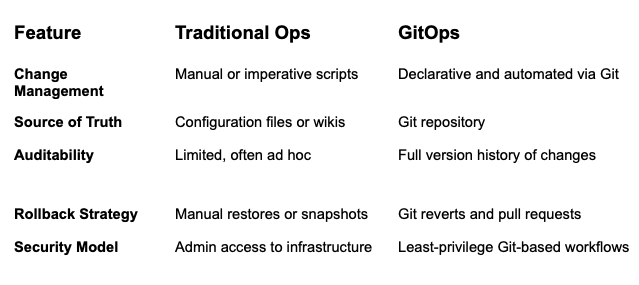Qu'est-ce que GitOps ?
GitOps apporte fiabilité, sécurité et rapidité aux déploiements en permettant des retours en arrière rapides, en améliorant la collaboration et en garantissant la cohérence entre les environnements. Lisez la suite pour découvrir pourquoi GitOps est idéal pour les architectures cloud-natives et basées sur Kubernetes et comment votre organisation peut rester à l'abri des cybermenaces.
Qu'est-ce que GitOps ?
GitOps est une pratique moderne de DevOps qui applique les principes de contrôle de version, de collaboration et d'automatisation à la gestion de l'infrastructure, permettant aux équipes de gérer les environnements de la même manière qu'elles gèrent le code - par le biais de demandes d'extraction, de revues de code et de pipelines automatisés.
GitOps permet des changements d'infrastructure plus rapides, plus sûrs et plus vérifiables en synchronisant l'état de vos systèmes directement à partir de vos dépôts Git à l'aide d'outils d'automatisation comme Argo CD ou Flux.
GitOps contre la gestion traditionnelle de l'infrastructure

GitOps applique les principes de l'infrastructure en tant que code (IaC), permettant aux équipes de gérer à la fois les applications et l'infrastructure avec les meilleures pratiques de développement logiciel.
Pourquoi GitOps est important
- Améliore la cohérence opérationnelle: L'automatisation des déploiements réduit les erreurs humaines.
- Amélioration de l'autonomie des développeurs: Les développeurs peuvent déployer du code à l'aide de demandes d'extraction sans accès direct à l'infrastructure.
- Permet des retours en arrière rapides et sûrs: Chaque modification est contrôlée par version et traçable.
- Prend en charge les architectures cloud-natives: Particulièrement puissant dans les environnements Kubernetes.
- Favorise la conformité et l'auditabilité: Les journaux Git fournissent une trace transparente de toutes les modifications.
GitOps aide à combler le fossé entre le développement et les opérations en fournissant une livraison continue avec une gouvernance solide.
Comment fonctionne GitOps
- Configuration déclarative
Les états de l'infrastructure et de l'application sont définis dans le code (YAML, Helm, etc.). - Contrôle de version via Git
Toute la configuration est stockée dans un dépôt Git, qui sert de source unique de vérité. - Synchronisation automatisée
Un opérateur GitOps (comme Argo CD ou Flux) surveille le repo Git et applique continuellement l'état déclaré à l'environnement réel. - Les demandes d'extraction comme mécanismes de changement
Toutes les modifications de l'infrastructure passent par des demandes d'extraction Git, ce qui permet la collaboration, l'approbation et la validation automatisée CI/CD.
Outils GitOps courants
- Argo CD: Un outil de livraison continue natif de Kubernetes qui tire les changements de Git.
- Flux: Un ensemble de composants GitOps pour Kubernetes, développé à l'origine par Weaveworks.
- Terraform + Git: Utilisé dans les flux de travail GitOps pour gérer l'infrastructure cloud de manière déclarative.
- Helm: Pour conditionner les applications Kubernetes sous forme de tableaux déclaratifs.
- Kustomize: Pour simplifier les superpositions de configuration dans les déploiements GitOps.
Cas d'utilisation de GitOps
- Gestion de l'environnement Kubernetes
- Orchestration multi-clusters
- Reprise après sinistre avec réhydratation de l'état basée sur Git
- Application de la politique et suivi de la conformité
- CI/CD sécurisé et auditable pour les industries réglementées
Foire aux questions
1. GitOps est-il réservé à Kubernetes ?
Non. Si GitOps a vu le jour avec Kubernetes, ses principes s'appliquent à tout système où l'infrastructure peut être définie de manière déclarative et déployée via l'automatisation.
2. Comment GitOps améliore-t-il la sécurité ?
En supprimant l'accès direct à la production et en imposant toutes les modifications par le biais de flux de travail Git, GitOps limite les privilèges et améliore l'auditabilité.
3. Quelle est la différence entre GitOps et DevOps ?
GitOps est une façon de mettre en œuvre DevOps en utilisant Git comme source de vérité, en mettant l'accent sur l'automatisation et la gouvernance de l'infrastructure.
Comment Illumio soutient la sécurité de GitOps
Alors que les entreprises adoptent GitOps pour rationaliser la fourniture d'applications et d'infrastructures, la sécurisation des environnements que ces pipelines touchent devient critique. Illumio aide à réduire les risques en contenant les mouvements latéraux dans les grappes Kubernetes, les instances cloud et les environnements de production liés aux flux de travail GitOps.
En associant l'automatisation pilotée par Git à la visibilité et à la segmentation en temps réel d'Illumio, les équipes peuvent maintenir des frontières de sécurité solides, même si l'infrastructure évolue continuellement.
Conclusion
GitOps transforme la façon dont l'infrastructure est gérée en appliquant aux opérations des pratiques de développement logiciel telles que le contrôle des versions, la collaboration et l'automatisation. En utilisant Git comme plan de contrôle central et en l'associant à des outils de déploiement automatisés, les entreprises gagnent en rapidité, en sécurité et en stabilité dans l'ensemble de leurs environnements.
.png)